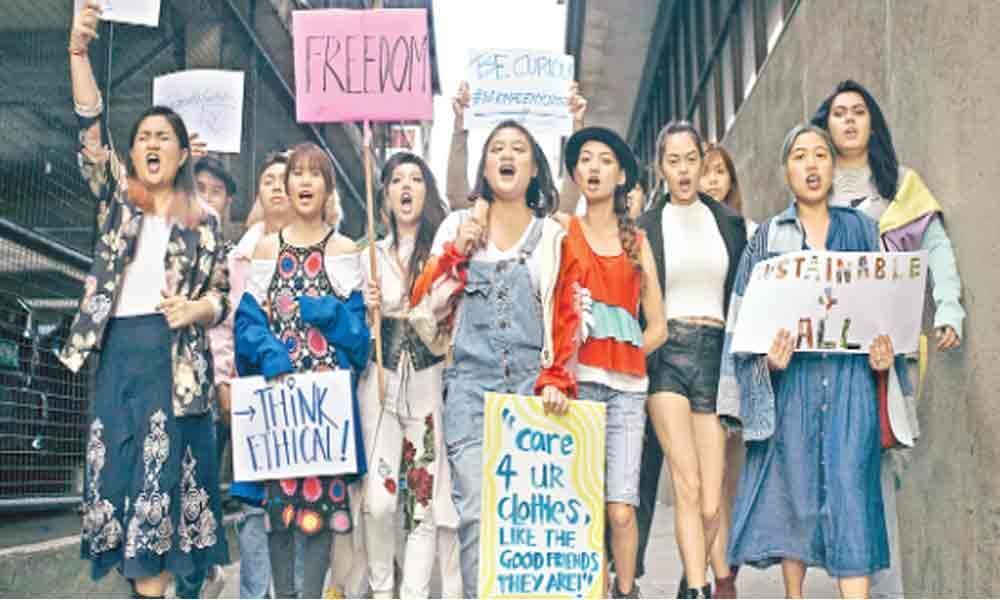Who made your clothes?
 Fashion Revolution Week in Beijing
Fashion Revolution Week in BeijingFashion is celebrated all across the world as people try to emulate fashionistas and come up with their own styles. Most of us are unaware of the tragedies and deplorable conditions of the workers in the fashion industry. Disasters in the fashion industry have caused great damage to the factory workers than to brands themselves.
Most reasons cited for such disasters are unplanned constructions, unauthorised renovations, minimal safeguards against fire or industrial accidents. On March 25, 1911 a fire at the Triangle Shirtwaist factory in New York City killed 146 garment workers, triggering the fashion industry. In 2005, KTS Textile Industries in Chittagong caught fire killing over 1,000 local garment workers that were struck in the factory, reason cited for the fire was a short circuit whereas it was reported that two electricians reportedly died in electrocution at this same facility in that year.
The Phoenix Building in the Tejgaon industrial area collapsed citing a transformer explosion and 57 workers at the Imam Group of Industries were injured. A fire tore through a textile factory in Karachi on September 11, 2012, killing more than 300 workers who were trapped within the building in barred windows and locked doors.
Many such accidents have happened in the past, and many go unnoticed. But these incidences draw the attention of the fashion industry to address the underlying health and safety issues in the garment and textile sectors. Unsuccessful implementation of the safety measures in these sectors has resulted in the death and injury of workers.
This is the area in the fashion industry where a not-for-profit organisation called the 'Fashion Revolution', is currently highlighting and trying to make change. The aim is to ensure workplace safety, value people, the environment, creativity and profit in equal measure.
It is making sure that this loss of life comes to an end and encourage people to embark on a journey to create a more ethical and sustainable future for fashion. It also acts as a platform for brands and customers to maintain transparency and ensure the safety of their workers.
'Fashion Revolution Week' is a global movement that campaigns for systemic reform of the fashion industry with a focus on the need for fairer, safer and greater transparency in the fashion supply chain. Fashion Revolution was started by Carry Somers and Orsola de Castro in 2013 in response to the Rana Plaza disaster in Dhaka, Bangladesh, the fourth largest industrial disaster in history.
Rana Plaza housed a number of garment factories, and when the building collapsed on April 24, 2013, about1,100 people were killed and 2,500 were injured. The tragedy highlighted the dreadful conditions that many people in the garment industry were working in. The campaigning organisation – Fashion Revolution, is working to end exploitation in the fashion industry.
'Fashion Revolution Week', encourages people around the globe to ask fashion and clothing brands 'Who made my clothes?' using the hashtag #WhoMadeMyClothes thereby demand greater transparency in the fashion supply chain. The need for such a movement was so dire that it has quickly grown into the world's largest global fashion activism movement.
'Fashion Revolution Week' provides the perfect platform to urge brands to put worker welfare, safety and environmental safeguards above shareholder profit. The core concept of this week is about demanding fair and decent conditions and pay, environmental protection and gender equality.
The organisation works all year round to raise awareness of the fashion industry's most pressing issues, advocate for positive change, and celebrate those who are on a journey to create a more ethical and sustainable future for fashion.
Fashion Revolution Week 2019 encourages people to recognise their own personal impact and value quality over quantity. The ultimate goal is to bring about a significant change in the thought process and instil the importance of dignity of labour.
This week aims to eradicate the evils of the fashion world as the campaigners strongly believe that we cannot live in a world where their clothes destroy the environment, harm or exploit people and reinforce gender inequality.
This year, Fashion Revolution kicked off the campaign on Earth Day, April 22, by signing the UN Fashion Charter for Climate Action, it pinpoints on educating the public about the devastating impact of the fashion industry on global warming and offering positive actions to reduce the carbon footprint of our clothes. Fashion Revolution also declared a Climate and Ecological Emergency, an environmental threat to our planet.
Many designers including Christopher Raeburn, Teatum Jones, Vivienne Westwood, Phoebe English, and Katharine Hamnett shared their processes, ideas and best practice. A few have raised their voice in the Fashion Open Studio 2019 with a week of talks, workshops and studio tours.
This has become a platform which celebrates transparency in the industry and shares real and positive solutions to create lasting change in the industry. Also launched on the same day was the Fashion Transparency Index on April 24, the biggest yet, with a listing of 200 brands.
Orsola de Castro said, "The spirit of Fashion Revolution is to engage in frank and topical dialogue with honesty at its core, and we are excited to be able to use our collective voice to be louder than ever before". "Ultimately, future generations are going to bear the cost of the unseen social and environmental impacts," said Carry Somers.
She further added that "Every time we buy, wear and dispose of clothes, we create an environmental footprint and impact the people who make them, most of whom are women. That's why positive change is more urgent than ever if we are to tackle climate change and create a more equitable future for all." While the sustainability of the fashion industry is increasingly under scrutiny, human rights abuses, gender inequality, and environmental degradation remain rife.

















